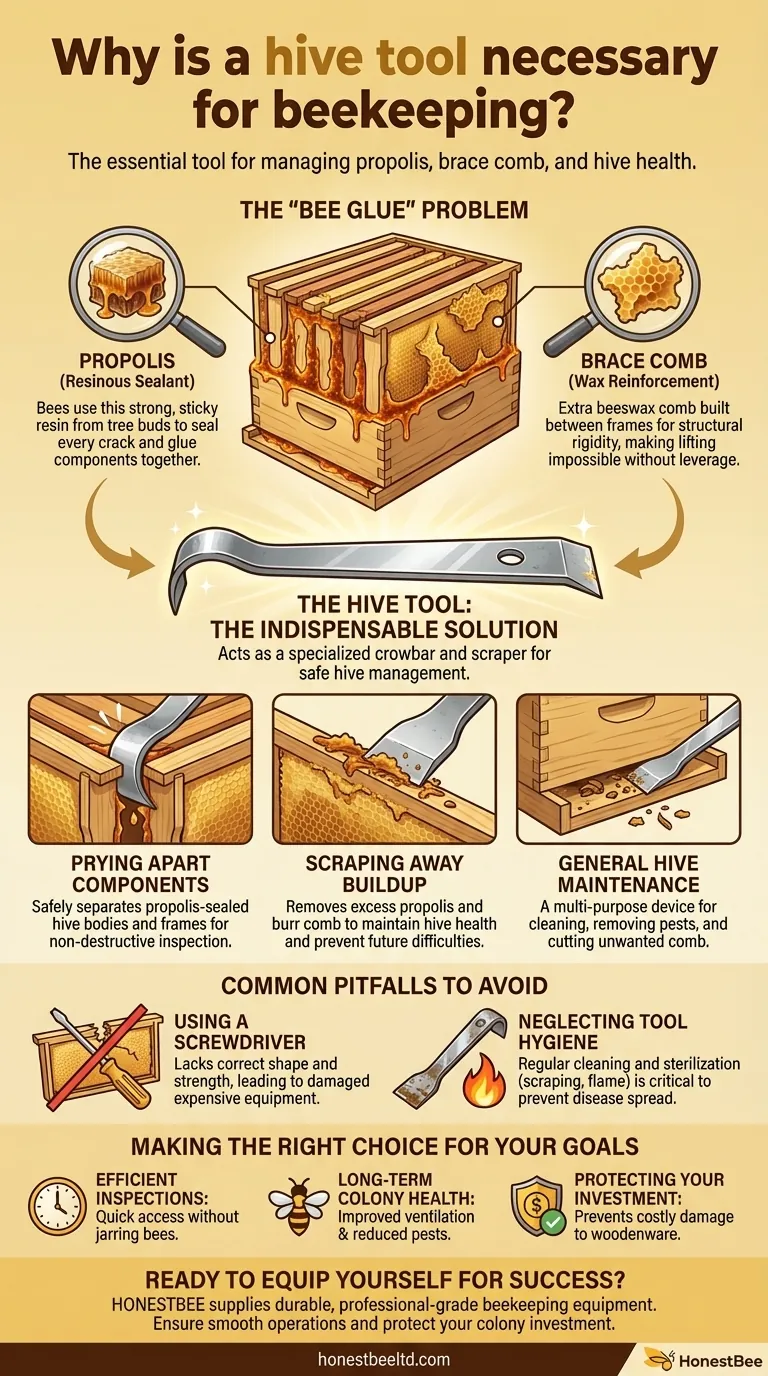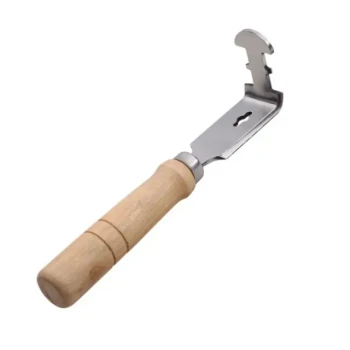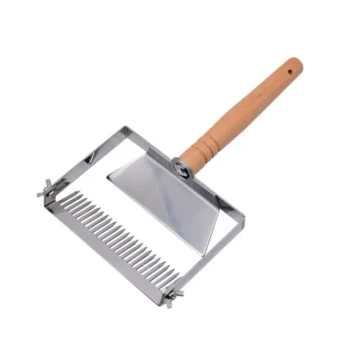A hive tool is necessary because honey bees seal every component of their hive together with a strong, sticky resin called propolis. Without this specialized tool, a beekeeper cannot safely pry apart frames or hive bodies for inspection, clean excess wax, or manage the colony effectively. It is the single most essential and frequently used piece of equipment for any hive-side work.
The core challenge in beekeeping is that bees actively work to glue their home into a single, solid structure. The hive tool is the indispensable solution, acting as a specialized crowbar and scraper that allows for safe and minimally invasive hive management.

The "Bee Glue" Problem: Propolis and Brace Comb
To understand the necessity of the hive tool, you must first understand the materials bees use to construct and fortify their home.
What is Propolis?
Propolis is a resinous mixture produced by bees from tree buds and other botanical sources. They use this incredibly strong and sticky substance as a sealant for unwanted open spaces.
Bees apply propolis to every crack and seam inside the hive, effectively gluing frames to the hive body and hive bodies to one another.
The Role of Brace Comb
Brace comb, or burr comb, is extra beeswax comb that bees build between frames or other hive components. They use it to reinforce structures and sometimes to connect parallel frames.
Like propolis, brace comb adds to the structural rigidity of the hive, making it impossible to simply lift frames out by hand.
Why Bees Seal Their Hive
This sealing behavior is a survival instinct. It provides structural integrity against weather and predators, prevents drafts, and helps maintain the colony's crucial internal temperature and humidity. For the beekeeper, however, this natural fortification turns the hive into a tightly sealed box that cannot be opened without leverage.
The Hive Tool as the Essential Solution
The hive tool is a simple but versatile metal bar designed specifically to overcome the challenges of propolis and brace comb. It serves several critical functions during every hive inspection.
Prying Apart Frames and Hive Bodies
The primary use of a hive tool is as a lever. One end is typically shaped for prying, allowing you to gently but firmly separate propolis-sealed hive bodies and break the seals on individual frames so they can be lifted for inspection.
Scraping Away Excess Buildup
The flat, sharpened edge of the tool is designed for scraping. This is used to remove excess propolis and brace comb from frames and the inside of the hive box. Regular cleaning prevents buildup that can make future inspections even more difficult.
Performing General Hive Maintenance
The hive tool is a multi-purpose device. It can be used to remove pests like wax moth larvae, cut out small sections of unwanted comb, and clean the hive entrance or bottom board.
Common Pitfalls to Avoid
While the tool is simple, its proper use and maintenance are key to protecting your bees and your equipment.
Why a Screwdriver Isn't a Substitute
Using a common screwdriver or putty knife is a frequent mistake made by new beekeepers. These tools lack the right shape and strength, often leading to splintered wood and damaged frames or hive bodies.
A proper hive tool is designed to distribute force correctly, minimizing damage to your expensive beekeeping equipment.
The Importance of Tool Hygiene
Propolis, wax, and honey can accumulate on your tool during an inspection. These substances can potentially harbor disease spores.
It is critical to clean your hive tool regularly, especially when moving between different apiaries. This can be done by scraping it clean, stabbing it into the ground, or quickly sterilizing it with the flame from your smoker.
Making the Right Choice for Your Goal
The hive tool is not just a tool; it's an enabler of proper hive management. Its use is central to achieving your beekeeping objectives.
- If your primary focus is efficient and safe inspections: The hive tool is your key to quickly opening the hive and separating frames without jarring the bees or rolling the queen.
- If your primary focus is long-term colony health: Using the tool to regularly scrape away excess propolis and burr comb improves ventilation and reduces hiding places for pests like hive beetles.
- If your primary focus is protecting your investment: A proper hive tool is the only way to work your hive without causing costly damage to your woodenware.
Ultimately, the hive tool is the essential bridge between the beekeeper and the otherwise impenetrable fortress of the honey bee colony.
Summary Table:
| Function | Purpose | Why It's Essential |
|---|---|---|
| Prying | Separates frames & hive bodies glued by propolis | Enables safe, non-destructive inspections |
| Scraping | Removes excess propolis & burr comb | Maintains hive health and prevents buildup |
| Multi-Use | General maintenance, pest removal, cleaning | The single most versatile tool for hive-side work |
Ready to equip yourself with the right tools for success?
A high-quality hive tool is the foundation of every beekeeper's toolkit. At HONESTBEE, we supply durable, professional-grade beekeeping supplies and equipment designed for the demands of commercial apiaries and distributors.
Ensure your operations run smoothly and protect your investment in your colonies. Contact our wholesale team today to discuss your equipment needs and discover the HONESTBEE difference.
Visual Guide

Related Products
- Professional Stainless Steel J-Hook Hive Tool
- Professional Stainless Steel Frame Cleaner with Ergonomic Wood Handle
- Professional Wide Blade Honey Scraper for Beekeeping and Honey Processing
- Stainless Steel Dual Blade Uncapping Plane
- Wide Adjustable Stainless Steel Honey Uncapping Fork with Scraper
People Also Ask
- What are the basic components of beekeeping equipment? Build a Thriving Hive from the Start
- What is a hive tool used for? The Essential Multi-Tool for Every Beekeeper
- What is a beekeeper tool? The Essential Multi-Purpose Lever for Hive Management
- What steps are involved in cleaning and sanitizing a hive tool? A Guide to Effective Apiary Biosecurity
- What is the function of a hive tool in beekeeping? The Essential Multi-Purpose Lever for Your Hive



















